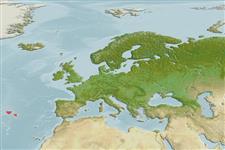>
Eupercaria/misc (Various families in series Eupercaria) >
Labridae (Wrasses)
Etymology: Symphodus: Greek, syn, symphysis = grown together + Greek, odous = teeth (Ref. 45335); caeruleus: Named for th edistinctive blue coloration of males..
Environment: milieu / climate zone / depth range / distribution range
Ecología
marino demersal; no migratorio; rango de profundidad 1 - 30 m (Ref. 35939), usually 5 - 15 m (Ref. 35939). Tropical; 39°N - 36°N, 32°W - 24°W
Distribución
Países | Áreas FAO | Ecosistemas | Ocurrencias, apariciones | Point map | Introducciones | Faunafri
Northeast Atlantic: Madeira, Canary Islands and the Azores Islands.
Tamaño / Peso / Age
Maturity: Lm ? range ? - ? cm
Max length : 21.5 cm SL macho / no sexado; (Ref. 35939); 17.5 cm SL (female)
Short description
Morfología | Morfometría
Espinas dorsales (total): 17 - 18; Radios blandos dorsales (total): 8-9; Espinas anales 5-6; Radios blandos anales: 7 - 9. Modal count of rays on dorsal fin 26 and anal fin 14; scales on lateral line 33-34; dark blue coloration of the males during spawning season (Ref. 35939).
Oviparous, distinct pairing during breeding (Ref. 205). Males build dish shaped nests and guard the eggs (Ref. 205).
Life cycle and mating behavior
Madurez | Reproducción | Puesta | Huevos | Fecundidad | Larva
Oviparous, distinct pairing during breeding (Ref. 205). Males build dish shaped nests and guard the eggs (Ref. 205).
Azevedo, M., 1999. Centrolabrus caeruleus sp.nov., a long unrecognized species of marine fish (Teleostei, Labridae) from the Azores. Bocagiana 196:1-11. (Ref. 35939)
IUCN Red List Status (Ref. 130435)
Threat to humans
Harmless
Human uses
Más información
PaísesÁreas FAOEcosistemasOcurrencias, aparicionesIntroduccionesStocksEcologíaDietacomponentes alimenticiosconsumo de alimentoRación
Age/SizeCrecimientoLength-weightLength-lengthLength-frequenciesMorfometríaMorfologíaLarvaDinámica larvariaReclutamientoAbundanciaBRUVS
ReferenciasAcuiculturaPerfil de acuiculturaRazasGenéticaElectrophoresesheritabilidadEnfermedadesProcesamientoNutrientsMass conversion
ColaboradoresImágenesStamps, Coins Misc.SonidosCiguateraVelocidadTipo de nataciónSuperficie branquialOtolitosCerebrosVisión
Herramientas
Special reports
Download XML
Fuentes de Internet
Estimates based on models
Preferred temperature (Ref.
123201): 18.7 - 19.1, mean 18.8 °C (based on 9 cells).
Phylogenetic diversity index (Ref.
82804): PD
50 = 0.5005 [Uniqueness, from 0.5 = low to 2.0 = high].
Bayesian length-weight: a=0.01000 (0.00473 - 0.02115), b=3.07 (2.90 - 3.24), in cm total length, based on LWR estimates for this Genus-body shape (Ref.
93245).
Nivel trófico (Ref.
69278): 3.5 ±0.5 se; based on size and trophs of closest relatives
Resiliencia (Ref.
120179): Medio, población duplicada en un tiempo mínimo de 1.4-4.4 años (Preliminary K or Fecundity.).
Fishing Vulnerability (Ref.
59153): Low vulnerability (16 of 100).
